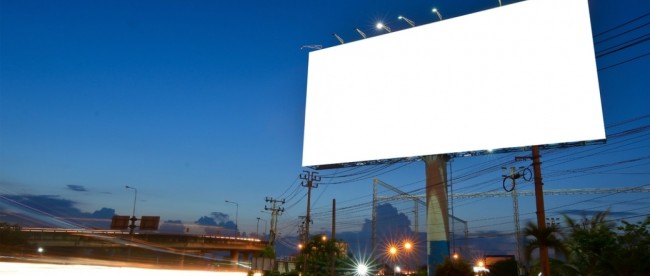To Boldly Go Where No Advertisement Has Gone Before

The International Space Station — if reduced to two dimensions — is roughly the size of a soccer pitch, at about 73 meters (239 feet) in length and 109 meters (356 feet) in width. It orbits the Earth at an altitude of 330 to 435 km (205 to 270 miles) — the distance from New York City to either Washington D.C. or almost to Pittsburgh — which is to say that it’s pretty far away, and certainly too far of a distance to watch a soccer match. Yet, from where you are right now, you may be able to see it at times. Here is NASA’s tool to help you “spot the station,” in their words. Using that tool, you’ll be able to spy the ISS from Earth for a few moments each month. If you know where to look, and when, the ISS will appear as a small, bright dot in moving across the sky.
But yes, it’s just a dot. At about 7,9000 m^2 — 0.0079 km^2 — the International Space Station isn’t large enough to appear as anything else. For example, it’s way too small to successfully deliver an advertisement to the people of Earth. That’s not for lack of trying, however.
In April of 1993, six years before ISS began circling the globe, a budding space entrepreneur wanted to bring the first ad into low Earth orbit. Dubbed Space Marketing, Inc., the Georgia-based company dreamed of launching a 1 km^2 illuminated sign into the sky and slightly beyond. As the Los Angeles Times reported a few months later, the idea was to take a huge piece of mylar, roll it up tightly, launch it about 240 km (150 miles) upward, and rig it so that it unfurled while in orbit. The “space billboard,” as Space Marketing called it, would “appear about half the size of the full moon” to those of us back home, per the Times.
While a company exec claimed that the seemingly floating ad would be unobtrusive (“Unless you’re trying to see it, you won’t”), most weren’t convinced. The idea was met with almost universal (planetary?) condemnation — from the publisher of AdAge and Carl Sagan, to Ralph Nader and members of the U.S. Congress. Congress acted, passing a law banning “obtrusive” space advertising, but the measure was more symbolic than anything else — there are other nations that go to space and some of them accept sponsor dollars. Space Marketing basically ignored that legal setback and still sought advertisers, telling the Los Angeles Times that they had as many as 11 potential leads.
Ultimately, society was spared having to be exposed to a pseudo-lunar billboard — but not because of the reasons above. Per a UN report (pdf), space junk was to blame. Low Earth orbit is home to a lot of former satellites and other space debris; the UN report noted that the proposed space billboard “was estimated to receive some 10,000 impacts of space debris per day” — way more than the mylar could handle — making it impossible for Space Marketing to secure further funding.
Bonus fact: Typically when you order a pizza, you pay the restaurant. But that’s not true if you’re ordering one on the International Space Station, or, more accurately, if Pizza Hut is sending you one. In 2001, Pizza Hut paid the Russian space agency $1 million to send a pizza to the ISS. (The sponsorship also included a Pizza Hut logo on a Soyuz rocket and a video of a cosmonaut Yuri Usachov giving a thumbs up after eating some of the pizza.) The space pizza, per the BBC, wasn’t a normal one, though: “spending a long time in space has the effect of deadening the taste buds, so extra salt and spices were added to the pizza. And salami had to be used as pepperoni lacked the necessary shelf life, growing moldy. ”
From the Archives: Space Needles: The story of some of that space junk.
Related: A lot of mylar — and yet, only about 0.0067 km^2 of it.
